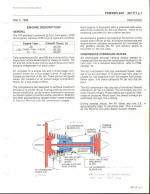
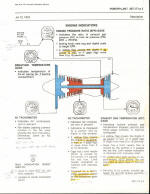
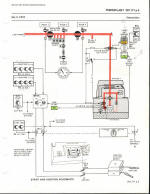
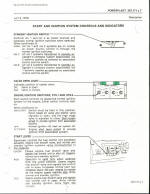
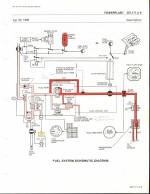
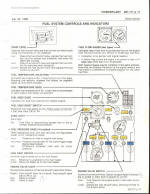

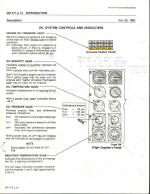
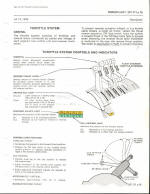
The Making of a Flight Engineer
Part 6: Airline experiences — Turbojets
by Floyd J. Stelly
Shortly after being hired by National Airlines in 1966, I applied for Boeing 727 ground school. The requirements for attending Flight Engineer School included possession of an instrument rating to fly on a pure jet, which I had. At the time I was selected, I didn’t realize that I was way out of sequence seniority-wise. Many engineers hired before me were still working on their flight rating while flying the Lockheed Electra. After check out, I remained dual-qualified. As those senior to me qualified, I flew the Electra more until the company sold them and became an all pure-jet airline. We didn’t have flight simulators at the time so training was done in the aircraft when it wasn’t on a scheduled flight, which meant late nights or very early mornings.
With the B-727, you could forget RPM, manifold pressure, cylinder head temp, and BEMP as used on piston engines. Now it was exhaust gas temperature, N-1 and N-2 in percent of RPM, and exhaust pressure ratio (called EPR). The Pratt & Whitney JT8 was very reliable and caused very few delays when considering the many short flights we made because of our route structure. Cruising speed was usually Mach 0.82 at altitude but was later lowered to Mach 0.78 when the price of fuel skyrocketed. Below 10,000 feet we cruised at 250 knots.
When a flight engineer was hired at National Airlines, he was also required to posses an A & P license. Because of the many cities we flew into didn’t have a maintenance station, you were expected to perform a limited amount of maintenance to prevent a flight delay or cancellation. I had to change one main wheel tire and made several manual engine starts at the engine. Replacing instruments, radio transceivers, radio components and navigation lights were among the many small tasks expected of the Flight Engineer. Once you were hired at National as a Flight Engineer, you remained at that position. New hire pilots went directly to the right seat. This was unlike some airlines, where you played musical chair by starting as flight engineer and then moveing to the co-pilots’ and captains’ positions. Part of our training was coordinated with maintenance personnel who kept you updated on all systems. We were able to tell them of our line experience problems.
A typical day when starting a trip, which lasted one to four days, was reporting to flight operations for aircraft number, gate and fuel load. Arriving at the aircraft one hour before departure, we performed the external and internal pre-flight, verified the fuel on board and air-conditioned the passenger cabin before boarding. Just before closing the loading door the station agent gave the flight engineer a weight and balance sheet that he used to complete the take off data information. The take off and landing data card was completed by the flight engineer for the gross weight, runway in use, temperature, flap setting, take off speeds and power setting. Unlike the aircraft equipped with piston engines, which use full power for take off, jet engine take off thrust can be reduced when conditions are right, such as light gross weight and long runways.
Engine starts were done by the Captain and Flight Engineer. The co pilot read the pre-flight and starting checklist. From then on, the Flight Engineer read all the checklists. After merging with Pan Am, most of these procedures were changed. The Captain and Co pilot completed the take off data based on projected passenger load. During taxi, the Engineer radioed flight operation for the final corrections and revised the take off data if necessary.
On take off, the power levers were advanced to allow the engines to spool up, which took several seconds. The Pilot making the take off advanced power to approximately take-off EPR, which was then trimmed by the Flight Engineer. The next power setting was climb thrust to altitude, and then cruise thrust after the desired Mach number which was reached. Charts gave the power setting for the desired Mach number, gross weight, temperature and altitude. Fuel tracking was continuous after take off. We radioed company dispatch to report departure times and expected arrival at the next stop. Before landing we gave our fuel request and received the gate number for parking. I recall one month, I bid a trip that left Jacksonville Florida at 6:00 PM, made six stops, returned to those same stops, and arrived back in Jacksonville at 2:00 AM. Never again — I went to sleep reciting the checklists.
I have to laugh when I see airport security today and recall back when the hotel taxicab or buss after a lay over would drive through the main gate to the ramp area and drop us off at the aircraft. Later as security tightened, we had to go through the same procedures as the passengers.
I’ve only had to shut down three engines, all because of oil pressure below minimum. One required that we jettison fuel to prevent an overweight landing. I had one engine flame out at the start of a take off roll due to a sheared fuel pump shaft. One of our crews had what they thought was a failed number three engine, while flying out West to California. After the shut down procedures were completed, the flight attendant came up, and said that the engine was no longer attached to the tail of the plane. On the 727, the forward lavatory service panel is located below the right side of the cockpit area. The toilet tank drain had an O-ring seal that was leaking. On a long high altitude flight, ice started building on the outside of the service panel. It got large and broke off going over the right inboard wing and into number three engine. I’m not sure if the engine was ever found, but I am sure it wasn’t repairable.
One common problem we had during the start of take off roll in a strong crosswind was a compressor stall in the number two engine. With number two, a long S-duct routed intake air. Unlike numbers one and three, which furnished bleed air for air-conditioning and cabin pressurization, the number two bleed valve was normally closed. A preventative measure was to bring engines one and three to take off thrust, and as air speed increased, bring in number two. Opening number two bleed and closing number three could also prevent a stall. You could also turn on the number two engine anti-icing bleed. The noise of the compressor stall upset the passengers, but I don’t recall any damage to the S-duct or engine.
All of the systems had some sort of back up feature in case of failure. The hydraulic system had two engine driven pumps and two electric pumps plus a standby system to extend the leading edge devices and operate the lower rudder. The landing gear could be lowered by use of a hand crank in the cockpit floor. Cable operated ailerons and elevators are provided with aerodynamic boost by use of their control tabs. Trailing edge flaps can be lowered electrically. A stabilizer trim wheel is located on each side of the cockpit pedestal can move the stabilizer manually by cable. The brake system uses air pressure if a complete loss of hydraulic pressure occurs. I found the hydraulic system very reliable and had very few leaks.
I have only experienced one landing gear problem that could have been serious. Flying between Charleston, South Carolina and Savannah, Georgia late one night the gear was lowered on approach to Savannah and the right main gear light did not come on. Hydraulic pressure was normal and emergency gear extension procedures didn’t help. There was a gear viewing hole in the mid cabin floor above the gear that I checked and saw that the right main gear had dropped onto the gear door, which was closed. The gear sequencing calls for the door to open, allowing the gear to lower and lock. Then the doors to close to reduced drag. Radio contact with maintenance didn’t offer any more advice except to try high speed dive and pull-up to impose a high-G load to break the door open. We proceeded to Orlando, Florida where the runway is long. We had help from the Air Force, which occupies one side of the field. They prepared to foam the runway in case we had to make a gear up landing. Not to make the passengers too sick and scared, the Captain did a mild dive and pull up, which didn’t change anything. The second try was a real wing bender and we got a green light. We landed on the foam runway and taxied to the gate. On inspection, I saw that the weight of the gear during the high-G pull up had broken the rods holding the gear door closed. The hydraulic actuator responsible for opening the gear door had broken loose at its anchor before the door opened. The landing gear extension sequence had continued despite the broken actuator, dropping the landing gear on a closed door. We put pins in the gear and ferried the aircraft to Miami with the gear down.
Unlike the Electra, which required full ground support, the 727 had an auxiliary power unit that furnished electric and pneumatic air-conditioning and engine starting. I feel like the Boeing 727 will be around like the Douglas DC-3, some of which are still flying. I flew the 727 for a total of 16 1/2 years, with a break of one year, during which time I flew DC10s. When the company sold the DC-10s, I re-qualified and flew the 727 again until I was awarded an opening on the Boeing 747.
 |
 |
 |
 |
 |
 |
 |
 |
 |
In February 1986, I started flight engineer transition training on the B-747 in Miami. This included ground school, flight simulator evaluation, and preline briefing completed by the end of March. An observation flight was scheduled from Miami to Los Angeles and a passenger flight with a check engineer to New York JFK airport and back to Los Angeles. A check ride was next from Washington Dulles airport to London and return to Miami. After this flight, I was signed off qualified to fly on my own. My first productive flight was in May from Miami to Rio de Janeiro.
The aircraft really impressed me—very reliable like the B-727; Huge, with eighteen wheels, carrying up to 412 passengers and a crew of 17. The workload was quite high when compared to other aircraft I’ve flown. If you weren’t writing or checking something, you were forgetting something. Fuel burn averaging 25,000 pounds per hour made fuel tracking versus flight plan consumption critical. Flight durations were usually 8-10 hours for international flying and 3–5 hours for domestic flights from the Miami base.
Take off gross weights are 734,000 pounds for the 100 series and 775,000 pounds for the 200. Engines are the JT9-3A, with 43,500 pound thrust, and the JT9-7A, with 46,150 pounds thrust. Pan Am also had some 747 SP long-range aircraft that were sold before I started training. This version is approximately 47 feet shorter than the standard 747. The APU is installed in the tail. In some aircraft can be run at attitudes up to 20,000 feet. Others can be run only on the ground. Fuel burn is approximately 900 pounds per hour, which is quite high for an APU
The engineer’s pre-flight inspection takes longer because of the aircraft size and the continued item discrepancy list in the aircraft log, which has to be checked against the minimum equipment list. This assures we are legal for departure and these items are reviewed with the pilots at the appropriate time on the checklist. The fuel load verification assures that the fuel gage indications equal, but not exceed by more than 2,000 pounds, the total fuel listed on the fuel loading form. The fuel density was always given for the fuel being added at that station. The sum of the fuel added in gallons times the density plus the fuel on board before fueling should be no more than 1000 pounds less or 3000 pounds more than the total fuel listed on the fuel loading form. If an error can’t be resolved, the measuring stick below each fuel tank can be used to confirm the load.
For engine starts, the APU usually furnished air for starting. If inoperative, a ground pneumatic cart could be used. If only one engine was started at the gate before push back, you could crossbleed start the other engines from the operative engine. Starting the JT9 was quite a bit different from any other engines I’ve encountered. The hydro-mechanical fuel control caused many potential hot starts. After each failed start, the EGT had to be cooled down by motoring the engine with the starter before another attempt. The pilot operated the start lever and the engineer called out the N2 RPM. Fuel was admitted at 22% and engine acceleration, fast or slow was called out. EGT over 400 degrees C and N2 RPM below 30% is a potential hot start and the fuel is cut. Motoring with the starter is continued until EGT is cooled below 200 degrees C before a second start attempt. Below 200 degrees C the start lever is again placed at idle. If this start is aborted again for high temperature, the starter is kept engaged to cool the EGT below 100 degrees C and the starter is released. The next attempt is made after positioning the aircraft into the wind and max motoring the N1 RPM before moving the start lever to idle. These hot start procedures were used very often on the JT-9 engine. I don’t recall ever having this problem on the B-727 or DC-10. Another start problem was the hung start, which was a very slow N2 acceleration with low EGT and fuel flow. Placing the start lever in the rich position increased fuel flow 100 pounds, advancing the throttle two knobs, and cycling the fuel boost pumps usually solved the problem. The engine idle fuel flow is 1,800 pounds per hour per engine. That’s about 4 ½ gallons per minute per engine. The APU burns approximately 134 gallons per hour.
The pre-taxi and taxi checklist is accomplished and I receive the weight and balance corrections from flight operations. We correct the take-off speeds and stabilizer trim setting if necessary. The desired EPR is set in each gage, which the engineer trims to after the pilot flying advances the power levers.
Take-off thrust EPR can be set at maximum for high gross weights or reduced up to 25% for lighter weights. Normal maximum thrust can also be increased by 0.02 EPR if air conditions packs are off to permit an even higher gross take-off weight. One -3A engine and three -7A engines are allowed to be installed on an aircraft if not enough 7-A engines are available.
Climb thrust is set after the gear and flaps are up. Some aircraft are equipped with a performance management system that when programmed will maintain desired speed by using the auto throttles during climb, cruise, and descent. This relieves the engineer from having to constantly adjust the throttles. Normal cruise speed for the B-747 is Mach 0.84. Fuel burn tracking is compared with the computerized flight plan at each waypoint to determine if an over burn is occurring and what action need be taken to correct this. Sometimes the route and altitude you requested is not available because of a delayed departure or weather enroute. Most flights were amazingly close to the flight plan both in time and fuel used.
After being at cruise altitude for a while the warm fuel you took on at the departure station starts to get cold and fuel control freezing can occur because of some water in the fuel. When the engine fuel temperature is -5 degrees C, cold water droplets on the fuel control internal linkages can freeze, causing the engine to spin down or run away at high power. As a precaution, when any engine fuel temperature is +5 degrees C or colder, fuel heat is used every 30 minutes on all engines, two at a time, for one minute. There are variations on these procedures, as the temperature gets colder. A temperature gage for number one tank is used to make sure the fuel temperature is at least 3 degrees C above the fuel freeze point. If approaching this temperature you can increase your Mach speed, reduce altitude, or deviate to an area of warmer temperature.
System wise the B-747 had the redundancy of the DC-10. The B-727 was similar except for the cable-operated backup for ailerons and elevators. The four hydraulic systems, one engine driven pump for each, also had four air driven pumps for backups. Leading edge flaps used pneumatic motors for normal operation and electric motors for backup. I’ve had to use this backup several times when a group of leading edge flaps didn’t extend before landing. Wing flaps use hydraulic pressure and electric motors for backup. The flight controls are powered by all four systems. The emergency checklist only assumes the loss of two systems. There was a loss of a B-747 when all systems failed as a result of a faulty aft bulkhead repair that ruptured all hydraulic plumbing. This was similar to the United DC-10 that lost all of its hydraulics and crashed in Iowa.
The landing gear can be extended and allowed to freefall and lock if pressure is lost. The four main gears have four brakes each with temperature sensors that are monitored during long taxiing and after hard braking during landing.
The Miami based flight crews only flew to London, Paris, and Frankfurt in Europe and Rio de Janeiro, Buenos Aires, and Guayaquil, Ecuador in South America with layovers. Intermediate stops were at Sao Paulo and Santiago. Departures were midnight for a morning arrival in South America. Returning to Miami, departures were midnight for a morning arrival. European departures and arrivals were best. Leaving Miami for a morning arrival in Europe, and leaving the next morning for an afternoon arrival in Miami was my favorite. We also had one domestic flight to Los Angeles, which departed at 8:00 in the morning. After a nice layover, we left for the next afternoon for a 10 P.M. arrival in Miami.
On one of my late night departures from Rio, we were notified shortly after takeoff by the flight attendant that a passenger appeared to be having a heart attack. This was verified by a doctor on board. We returned for landing, but being overweight had to jettison 100,000 pounds of fuel to bring us to maximum landing weight. Dumping 5,000 pounds per minute took 20 minutes. Recommended altitude for dumping is 6,000 feet or greater to minimize ecological damage. After landing and taxiing to the gate, we refueled. I asked for fans or air conditioning units to cool the brakes, which were quite hot. None were available. About five minutes after parking, the fuse plug in one tire melted and released the air. The tire was replaced and we waited the appropriate amount of time before departure for tire and brake cooling, as recommended by the brake energy chart.
The five and one-half years I flew the 747 didn’t require an in-flight engine shutdown except for an over temp at start or descent when a bleed valve malfunctioned as power was reduced. Procedure is to place start lever to cutoff, dual ignition on and when EGT start to decrease, place start lever to idle. This usually works, and a similar problem such as coming out of reverse can overtemp. You cut the fuel and when N2 RPM drops below 25%, engage the starter and cool EGT below 100 degrees C, and restart engine.
I found the oil consumption on the JT-9 to be greater than the general electric CF-6 because of normal consumption and external leaks. On one eight-hour flight I had an engine use all seven gallons as indicated by the gage. Oil pressure was normal to arrival at gate. Alternate procedure allowed continued operation with zero oil quantity and oil pressure in the green band.
The flight can be dispatched with one generator inoperative. On one night flight from Rio to Miami I had a second generator fail. Monitoring the electric load became important because of the high galley power required during the meal service. There is an electric load reduction list of items that can be turned off if necessary to keep the total load within limits. Should loss of all generators occur, all electric fuel pumps are inoperative. Engines will probably all spool down because of fuel starvation on suction feed of the fuel control pumps. There is an in-flight start procedure for all engines wind milling while descending at 250 knots below 30,000 feet.
Because of its weight and size, the 747 can ride out rough weather without bouncing too badly. The worst departure weather I’ve experienced was out of Buenos Aires, Argentina late one night for Miami. I left the hotel during heavy rain and lightning and arrived at the airport to find a power outage. The continuous rain caused me wait until the last minute to do the outside pre-flight. Taxiing out you could feel the strong gusty wind with rain. Taking off and using maximum power for the high gross weight, we used most of the runway. After lift off and starting climb, the ground proximity warning system became activated saying "don’t sink" which meant we lost a small amount of altitude during the take-off regime. The flaps were retracted on schedule to gain speed. Then, the stick shaker went off indicating an approach to a stall condition. Correcting that, the radar became inoperative, so we switched to a spare radar transmitter-receiver. This took a long minute before it would paint a weather picture, next, ice was forming so engine anti-ice was turned on. It took us 20 minutes of climbing and deviating weather to break out in the clear.
During the first gulf war I tried to volunteer to fly our troops to Saudi Arabia but that was assigned to the New York based crews. Pan Am participated with the government in the civil reserve air fleet program to fly troops in event of war. I flew soldiers from U.S. bases to New York, JFK airport, and New York crews flew to Rome where they had a layover. Another crew continued to Riyadh, Saudi Arabia and back to Rome, and another crew returning the aircraft to New York. After the war ended, I flew some of the returning troops from New York to their home base.
I tried to bid and fly more trips to Europe for the more desirable daylight flying. When I commuted and arrived at my home in Louisiana after returning from a trip I had been awake over 24 hours. I sometimes bid to fly back-to-back trips to get more days off to spend at home.
After flying the 747 for five and one-half years and approaching my 62nd birthday in October 1991, I decided to retire effective November 1st. Unlike pilots, a flight engineer can continue flying past age 60, if he desires. My retirement date was ironic because Pan Am went out of business on December 4th. Jokingly I tell my friends they couldn’t make it without me. The only effect on my retirement was not flying at a reduced fare on my airline. No problem, because I was tired of traveling anyway. I returned to my home in Gonzales, Louisiana to start enjoying my retirement. It’s been a great run and I enjoyed my 40 years as a professional flight engineer.
Part 1: C-54s, DC-4s and C-82s in Europe
Part 2. Back Stateside – C-119s from Miami to Greenland
Part 3. Stateside - C-124s
Part 4. Airline Experiences – Lockheed Constellations, Douglas DC-6s and DC-7s
Part 5. Airline experiences – Lockheed L-188 Electra